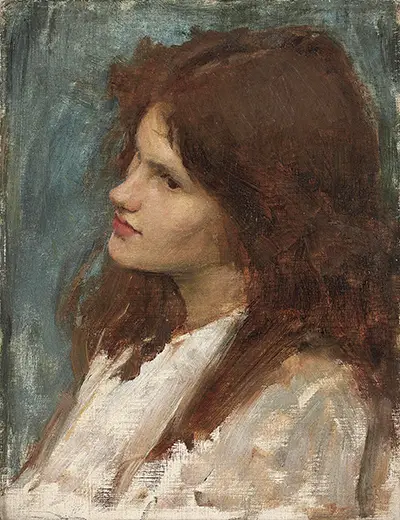The artist worked tirelessly to perfect his knowledge and understanding of portrait drawing and painting as this genre lied at the core of almost all of his artwork. He practiced in pencil and chalk most frequently but as in this case he would sometimes produce fast, brief oil studies of his models in order to bridge the gap between drawing and the final oil piece. He would not have considered these studies to be valuable but today they can certainly still fetch many thousands of pounds as the artist retains a list of interested collectors who seek to acquire any of his work which can still appear at auction every now and again. Such studies also provide historians and critics with a view into an artist's work practices, seeing how they construct their compositions and the efforts that they make in preparation, prior to starting each of the main works. One can also compare the different phases to see how many amendments have been made as the idea develops.
Here we see a beautiful young woman looking off to our left, seemingly in a trance as thoughts occupy her mind. Waterhouse's women would typically look distracted and unaware of the viewer's presence, and so he rarely worked within the more formal methods of portraiture where artist and model would look directly at each other. She has brown hair, with perhaps a tinge of red, which hangs down to her shoulders and a small amount of red lipstick, possibly. Waterhouse loved his models to look natural, and so would never overdo their clothing and also used little makeup in most cases. He wanted to create an atmosphere of innocence and feminine, natural beauty and so also tended to go for particularly slim, young women with the palest of complexions. This look became a key part of his career and made many of his paintings instantly recognisable as his own, even though many other artists of this period would do the same, including members of the Pre-Raphaelite movement, with whom his career was closely linked.
Waterhouse is one of the most loved British artists from the Victorian period but actually was just one of a number who worked in a similar way during this time. Another of note would be Frank Dicksee, a similarly qualified artist who studied at the Royal Academy and left behind an oeuvre which boasted the same literary-inspired content as Waterhouse. Some of his biggest achievements include the likes of The Funeral of a Viking, Passion and An Offering. Although his name is not as prominent as Waterhouse's, he has never fallen from out of favour and is continually discussed within this overall umbrella of different styles during that era. He also received a major publication in recent years which has brought his oeuvre to the attention of many people for the very first time.

